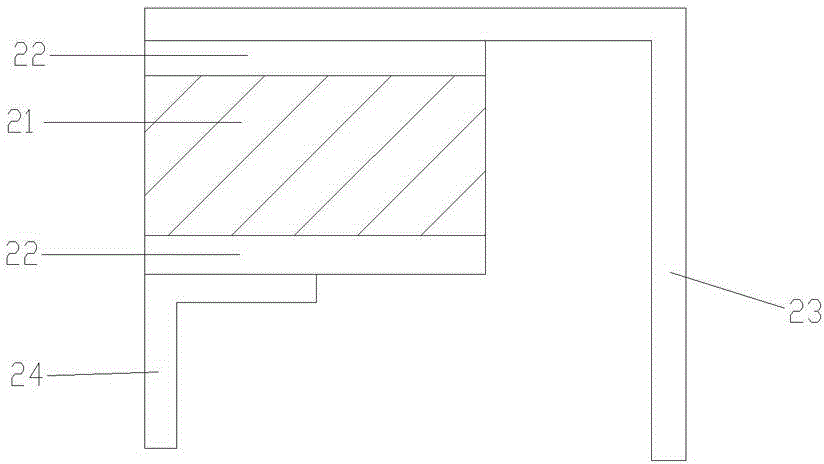PTC thermistor and substrate applied therein and manufacturing method thereof
A technology of thermistor and manufacturing method, applied in the direction of resistors with positive temperature coefficient, etc., can solve the problems of poor ability to withstand high current multiple shocks, low PTC strength, etc., and achieve the ability to withstand high current multiple shocks Good, low resistance, the effect of inhibiting agglomeration
- Summary
- Abstract
- Description
- Claims
- Application Information
AI Technical Summary
Problems solved by technology
Method used
Image
Examples
preparation example Construction
[0061] The present invention also proposes the second preparation method of the thermistor, which includes the following steps:
[0062] Step 1: Preheat the conductive filler and auxiliary filler at 70-180°C for 2-24 hours for use;
[0063] Step 2: Pre-mix a polymer material, auxiliary fillers, and antioxidants to make a masterbatch. After mixing with another polymer material at room temperature, it will be mixed with conductive fillers, coupling agents, crosslinking agents, and sensitizers. The crosslinking agent is mixed at a temperature of 30-60°C above the melting point of the polymer material and then extruded or hot-pressed by a single-screw extruder;
[0064] Step 3: The metal electrodes are combined on the upper and lower surfaces of the sheet by hot pressing, and heat treatment is carried out. The chips are punched on a punch and subjected to gamma rays, electron accelerators or cobalt sources (Co 60 ) Perform radiation cross-linking, the radiation dose is 70~200KGY;
[0065]...
Embodiment 1
[0069] The conductive filler and auxiliary filler are pre-heated in a 110 degree oven for 4 hours, and then the conductive filler: carbon black (VXC200 model produced by Cabot, USA) 660g,
[0070] Auxiliary filler: 600g magnesium hydroxide,
[0071] Coupling agent: vinyl triethoxy silane 24g
[0072] Mix it evenly in a high-speed mixer, and combine the above mixture with high-density polyethylene 1000g,
[0073] Crosslinking agent: DCP (Dicumyl Peroxide) 3.6g,
[0074] Sensitizing crosslinking agent: 30g of trimethylolpropane triacrylate,
[0075] Antioxidant: Tetra [methyl-β-(3,5-di-tert-butyl-4-hydroxyphenyl) propionate] pentaerythritol ester (antioxidant 1010) 4g, and tris(2,4-diphosphite) Tert-butylphenyl) ester (antioxidant 168) 12g,
[0076] Add to the internal mixer for mixing at 180°C. After the mixing time is 10 minutes, the material is discharged and crushed. The crushed material is uniformly mixed at room temperature and then mixed in a twin-screw extruder. The temperature of ...
Embodiment 2
[0083] The conductive filler and auxiliary filler are preheated in a 110 degree oven for 4 hours, and then the conductive filler: carbon black (VXC605 model produced by Cabot, USA) 460g,
[0084] Auxiliary filler: 800g alumina,
[0085] Mix well at room temperature, then combine the above mixture with
[0086] Polymer material: high density polyethylene 800g,
[0087] Sensitizing crosslinking agent: trimethylolpropane trimethacrylate 20g,
[0088] Add to the internal mixer for mixing at 180°C. After the mixing time is 10 minutes, the material is discharged and crushed. The crushed material is uniformly mixed at room temperature and then mixed in a twin-screw extruder. The temperature of each section of the extruder Respectively set to 170℃180℃190℃200℃, extrude the sheet into a sheet with a thickness of 1.6mm;
[0089] The nickel foil that has been roughened on one side is laminated on the upper and lower surfaces of the above-mentioned sheet by a flat vulcanizer, the pressure is 8MPa, a...
PUM
| Property | Measurement | Unit |
|---|---|---|
| thickness | aaaaa | aaaaa |
| electrical resistance | aaaaa | aaaaa |
Abstract
Description
Claims
Application Information
 Login to View More
Login to View More - R&D
- Intellectual Property
- Life Sciences
- Materials
- Tech Scout
- Unparalleled Data Quality
- Higher Quality Content
- 60% Fewer Hallucinations
Browse by: Latest US Patents, China's latest patents, Technical Efficacy Thesaurus, Application Domain, Technology Topic, Popular Technical Reports.
© 2025 PatSnap. All rights reserved.Legal|Privacy policy|Modern Slavery Act Transparency Statement|Sitemap|About US| Contact US: help@patsnap.com

